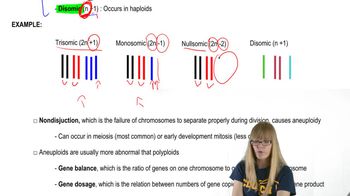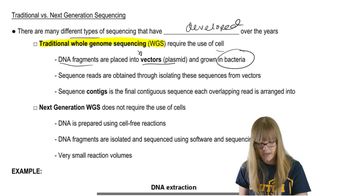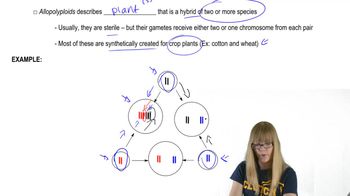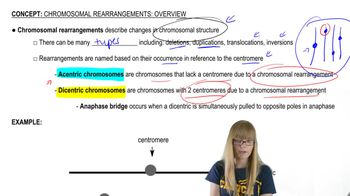Table of contents
- 1. Introduction to Genetics51m
- 2. Mendel's Laws of Inheritance3h 37m
- 3. Extensions to Mendelian Inheritance2h 41m
- 4. Genetic Mapping and Linkage2h 28m
- 5. Genetics of Bacteria and Viruses1h 21m
- 6. Chromosomal Variation1h 48m
- 7. DNA and Chromosome Structure56m
- 8. DNA Replication1h 10m
- 9. Mitosis and Meiosis1h 34m
- 10. Transcription1h 0m
- 11. Translation58m
- 12. Gene Regulation in Prokaryotes1h 19m
- 13. Gene Regulation in Eukaryotes44m
- 14. Genetic Control of Development44m
- 15. Genomes and Genomics1h 50m
- 16. Transposable Elements47m
- 17. Mutation, Repair, and Recombination1h 6m
- 18. Molecular Genetic Tools19m
- 19. Cancer Genetics29m
- 20. Quantitative Genetics1h 26m
- 21. Population Genetics50m
- 22. Evolutionary Genetics29m
6. Chromosomal Variation
Chromosomal Rearrangements: Overview
Problem 3
Textbook Question
Define these pairs of terms, and distinguish between them. aneuploidy/euploidy monosomy/trisomy Patau syndrome/Edwards syndrome autopolyploidy/allopolyploidy autotetraploid/amphidiploid paracentric inversion/pericentric inversion
 Verified step by step guidance
Verified step by step guidance1
Step 1: Define aneuploidy and euploidy. Aneuploidy refers to a condition where the number of chromosomes is not an exact multiple of the haploid number, leading to a gain or loss of chromosomes. Euploidy, on the other hand, is when the number of chromosomes is an exact multiple of the haploid number, resulting in a balanced set of chromosomes.
Step 2: Define monosomy and trisomy. Monosomy is a type of aneuploidy where there is a loss of a single chromosome (2n-1), while trisomy is a condition where there is an extra chromosome (2n+1).
Step 3: Define Patau syndrome and Edwards syndrome. Patau syndrome is a genetic disorder caused by trisomy of chromosome 13, while Edwards syndrome is caused by trisomy of chromosome 18. Both are characterized by severe developmental and physical abnormalities.
Step 4: Define autopolyploidy and allopolyploidy. Autopolyploidy occurs when an organism has more than two sets of chromosomes, all derived from a single species. Allopolyploidy involves multiple sets of chromosomes derived from different species, often resulting from hybridization.
Step 5: Define autotetraploid and amphidiploid. An autotetraploid is an organism with four sets of chromosomes, all from the same species. An amphidiploid, also known as an allotetraploid, is an organism with two sets of chromosomes from each of two different species, often resulting from hybridization and chromosome doubling.
Recommended similar problem, with video answer:
 Verified Solution
Verified SolutionThis video solution was recommended by our tutors as helpful for the problem above
Video duration:
1mPlay a video:
Was this helpful?
Key Concepts
Here are the essential concepts you must grasp in order to answer the question correctly.
Aneuploidy vs. Euploidy
Aneuploidy refers to an abnormal number of chromosomes in a cell, resulting from nondisjunction during meiosis or mitosis, leading to conditions like Down syndrome. In contrast, euploidy is the normal state of having a complete set of chromosomes, which can be haploid (one set) or diploid (two sets), and is essential for normal development and function.
Recommended video:
Guided course

Aneuploidy
Monosomy vs. Trisomy
Monosomy is a type of aneuploidy where one chromosome from a pair is missing, resulting in a total of 45 chromosomes, as seen in Turner syndrome. Trisomy, on the other hand, occurs when there is an extra chromosome in a pair, leading to 47 chromosomes, with Down syndrome being a common example of this condition.
Recommended video:
Guided course

Traditional vs. Next-Gen
Autopolyploidy vs. Allopolyploidy
Autopolyploidy is the condition where an organism has more than two sets of chromosomes derived from a single species, often resulting from errors in meiosis. Allopolyploidy involves the combination of chromosome sets from different species, leading to hybrid organisms that can be fertile, such as in many plant species, and is crucial for speciation.
Recommended video:
Guided course

Allopolyploidy

 4:38m
4:38mWatch next
Master Rearrangement Overview with a bite sized video explanation from Kylia Goodner
Start learningRelated Videos
Related Practice


